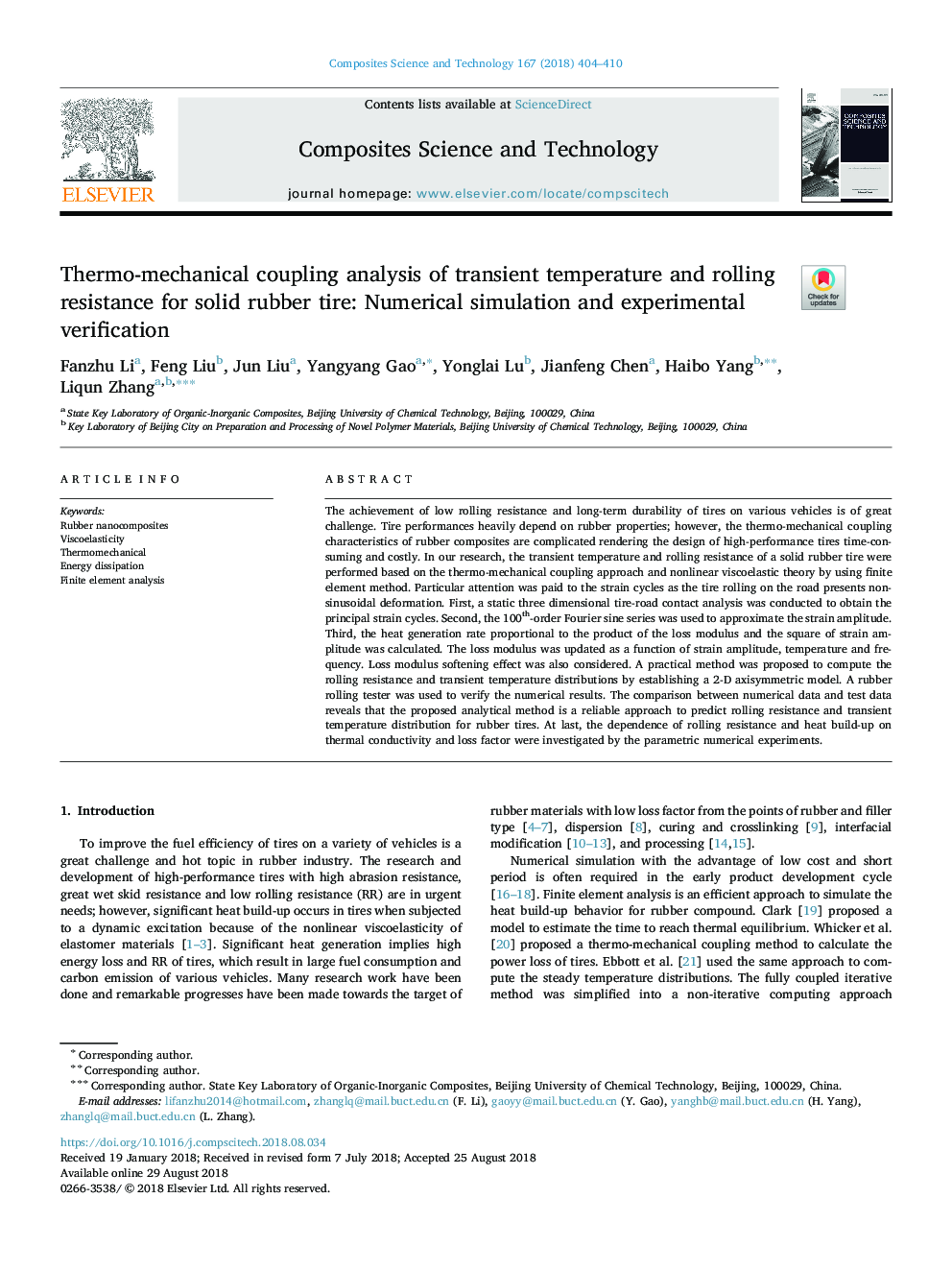| کد مقاله | کد نشریه | سال انتشار | مقاله انگلیسی | نسخه تمام متن |
|---|---|---|---|---|
| 11004260 | 1469459 | 2018 | 7 صفحه PDF | دانلود رایگان |
عنوان انگلیسی مقاله ISI
Thermo-mechanical coupling analysis of transient temperature and rolling resistance for solid rubber tire: Numerical simulation and experimental verification
ترجمه فارسی عنوان
تحلیل حرارتی مکانیکی دمای گذرای و مقاومت نورد برای تایر لاستیکی جامد: شبیه سازی عددی و تأیید آزمایشی
دانلود مقاله + سفارش ترجمه
دانلود مقاله ISI انگلیسی
رایگان برای ایرانیان
کلمات کلیدی
ترجمه چکیده
دستاورد مقاومت کم نورد و دوام طولانی مدت لاستیک در وسایل نقلیه مختلف از چالش های بزرگی است. عملکرد تایر به شدت به خواص لاستیک بستگی دارد؛ با این حال ویژگی های ترمو مکانیکی کوپلینگ کامپوزیت های لاستیکی پیچیده است که طراحی لاستیک های با عملکرد بالا را زمان گیر و پرهزینه می کند. در تحقیق ما، درجه حرارت گذرا و مقاومت نورد یک تایر لاستیکی جامد بر اساس رویکرد اتصال جابجایی حرارتی و مکانیکی و تئوری ناهمسانسی ویسکوالاستیک با استفاده از روش المان محدود انجام شد. توجه ویژه به سیکل های فشار در صورت عدم چرخش تایر در جاده ها، تغییر شکل غیر سینوسی را نشان می دهد. برای اولین بار، یک سیکل تماس سه بعدی اتوبوسرانی به منظور دستیابی به چرخه های اصلی کرنش انجام شد. دوم، سری سینوس فوریه 100 مرتبه برای تقریب دامنه فشار استفاده شده است. سوم، نرخ تولید گرما، متناسب با محصول مدول افت و مربع دامنه کرنش محاسبه شد. مدول از دست دادن به عنوان تابع دامنه، دما و فرکانس فشار است. اثر نرم افزاری کاهش وزن نیز مورد توجه قرار گرفت. یک روش عملی برای محاسبه مقاومت نوردی و توزیع درجه حرارت گذار با ایجاد مدل دو بعدی دو بعدی پیشنهاد شده است. برای تایید نتایج عددی، تستر رول لاستیکی استفاده شد. مقایسه داده های عددی و داده های آزمایشگاهی نشان می دهد که روش تحلیلی پیشنهادی یک رویکرد قابل اعتماد برای پیش بینی مقاومت نورد و توزیع دمای گذرا برای لاستیک لاستیک است. در نهایت، وابستگی مقاومت نوردی و گرمای بالا بر روی هدایت حرارتی و ضریب تلفات توسط آزمایش های عددی پارامتری مورد بررسی قرار گرفت.
موضوعات مرتبط
مهندسی و علوم پایه
سایر رشته های مهندسی
مهندسی (عمومی)
چکیده انگلیسی
The achievement of low rolling resistance and long-term durability of tires on various vehicles is of great challenge. Tire performances heavily depend on rubber properties; however, the thermo-mechanical coupling characteristics of rubber composites are complicated rendering the design of high-performance tires time-consuming and costly. In our research, the transient temperature and rolling resistance of a solid rubber tire were performed based on the thermo-mechanical coupling approach and nonlinear viscoelastic theory by using finite element method. Particular attention was paid to the strain cycles as the tire rolling on the road presents non-sinusoidal deformation. First, a static three dimensional tire-road contact analysis was conducted to obtain the principal strain cycles. Second, the 100th-order Fourier sine series was used to approximate the strain amplitude. Third, the heat generation rate proportional to the product of the loss modulus and the square of strain amplitude was calculated. The loss modulus was updated as a function of strain amplitude, temperature and frequency. Loss modulus softening effect was also considered. A practical method was proposed to compute the rolling resistance and transient temperature distributions by establishing a 2-D axisymmetric model. A rubber rolling tester was used to verify the numerical results. The comparison between numerical data and test data reveals that the proposed analytical method is a reliable approach to predict rolling resistance and transient temperature distribution for rubber tires. At last, the dependence of rolling resistance and heat build-up on thermal conductivity and loss factor were investigated by the parametric numerical experiments.
ناشر
Database: Elsevier - ScienceDirect (ساینس دایرکت)
Journal: Composites Science and Technology - Volume 167, 20 October 2018, Pages 404-410
Journal: Composites Science and Technology - Volume 167, 20 October 2018, Pages 404-410
نویسندگان
Fanzhu Li, Feng Liu, Jun Liu, Yangyang Gao, Yonglai Lu, Jianfeng Chen, Haibo Yang, Liqun Zhang,
